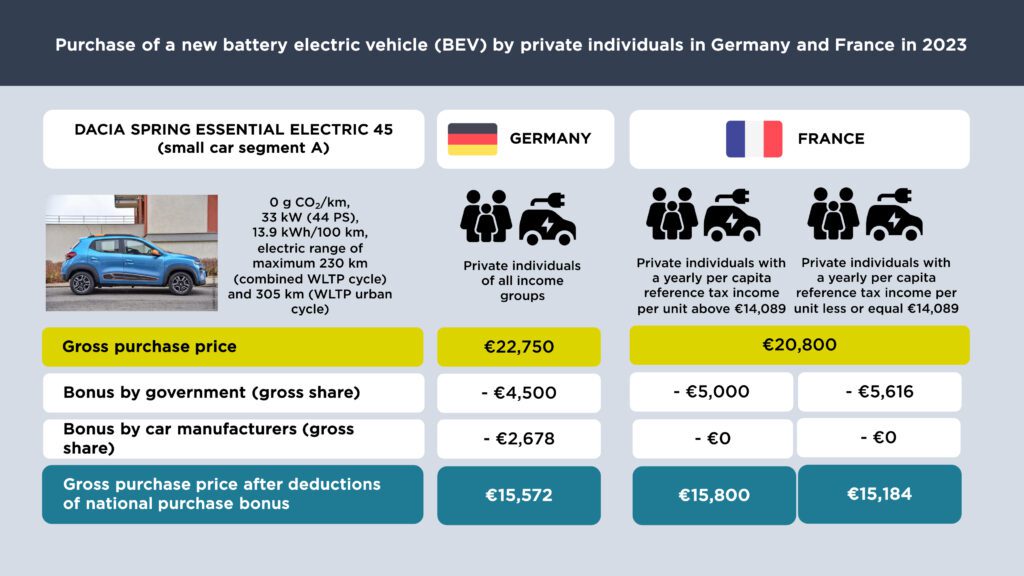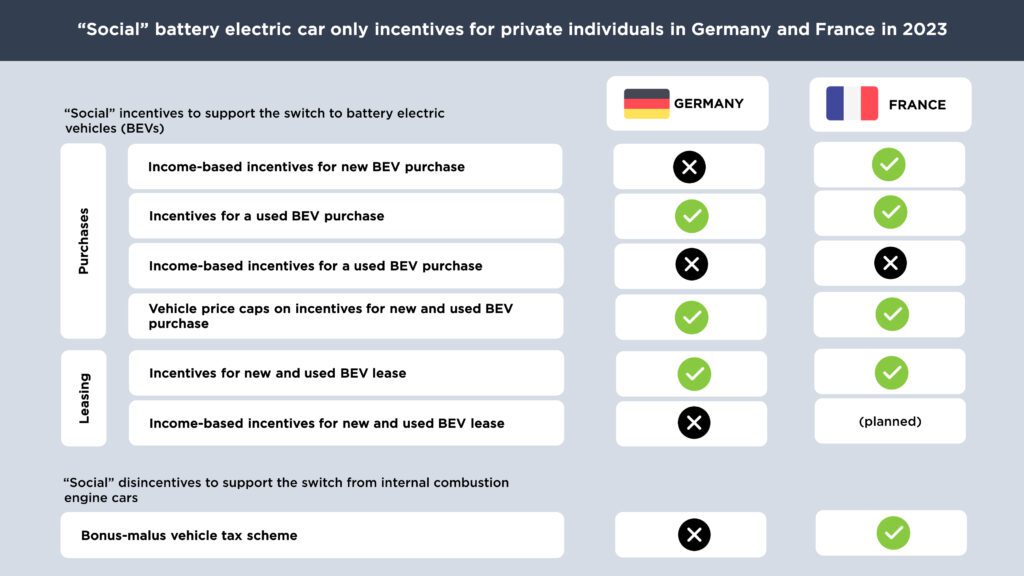Blog
Making electric cars affordable: How Germany and France are targeting people with lower incomes
Battery electric cars have become the best purchase option to benefit our lungs and climate but are not currently the best option for all wallets. The stakes are even higher for those who are on a tight budget and depend on a car for their daily mobility. If no action is taken in the short term, there is a serious risk of leaving people with lower incomes behind in the transition to battery electric vehicles (BEVs).
In Germany and France, the two largest passenger car markets in Europe by new sales, the market for BEVs is evolving rapidly with new registrations reaching 18% and 13%, respectively, in 2022. But low-cost BEV models are still rare compared to internal combustion engine vehicles (ICEVs). A new battery electric Dacia Spring, a small car in the lower price segment, still seems out of reach for many—its price tag roughly equals the median yearly disposable income per capita in Germany (about €23,000) and France (about €20,000). Both countries have already made important efforts with a variety of tax and purchase incentives designed to make BEVs more affordable in general. But what policies exist to support people dependent on a car who have lower incomes?
Three key aspects matter in this respect when designing national income-based policies for BEVs: how purchase incentives are defined according to income levels, the price cap on vehicles that qualify for a purchase incentive, and what type of vehicle is eligible, being it a new or a used model. Other policy types, such as those supporting leasing options like the planned social leasing program in France, can also be a game-changer making BEVs more affordable for people in lower income groups.
Providing income-based incentives for new BEVs purchases
When buying a new BEV in Germany or France, the maximum subsidy amounts differ slightly, as do the eligibility requirements. In Germany, all private buyers receive the same amount of assistance independent of income. The one-time purchase bonus from the government is worth a maximum of €4,500. With the €2,250 (net) contributed by the automakers, any buyer can receive up to €6,750.
France, on the other hand, distinguishes between households with lower and higher incomes. Individuals who earn up to €14,089 (annual per capita reference tax income) can receive a purchase bonus up to €7,000, while those above this threshold are offered a maximum aid of €5,000. The maximum aid amount in France is capped at 27% of the vehicle’s gross purchase price.
As shown in Figure 1, reducing the purchase price of a Dacia Spring by applying only the national and manufacturer’s purchase bonuses would lead to a similar final price tag with less than a €400 difference—around €15,600 in Germany and €15,200 in France for people with lower incomes. In the case of France, the maximum bonus is not applicable for the comparably low-priced BEV model.

Figure 1. Effects of national one-time purchase bonus for the purchase of a new battery electric Dacia Spring on the final purchase price in Germany and France.
Providing income-based incentives for used BEV purchases
If government policies aim to target drivers with lower incomes, there may be an even better case for incentivizing used BEV purchases. These vehicles are often the first option for people with lower incomes due to their lower price tag compared to new models. Both Germany and France provide purchase incentives for used BEVs, although not based on income.
In Germany, the government purchase bonus for a used BEV is €3,000, and manufacturers offer an additional €1,500. While the German bonus appears to be high, a variety of preconditions have to be met. For example, a new purchase bonus cannot have already been applied to the vehicle, the BEV can only have been registered for a maximum of 12 months and have a maximum mileage of 15,000 km. In France, the purchase bonus for a used BEV is €1,000. To qualify, the vehicle must be at least two years old from the first registration, purchased from a dealer, and kept for at least 2 years. The used BEV bonus can be awarded a maximum of once every 3 years.
While neither Germany or France have adopted a purchase bonus for used BEVs dependent on income, such policies exist outside Europe, such as in the states of California and Pennsylvania in the United States.
Implementing vehicle price caps on incentives for new and used BEV purchases
Setting price caps on BEVs that qualify for purchase incentives can prevent giving money to those who can afford a new, high-priced car. In Germany, the maximum government bonus amount of €4,500 is paid if the new BEV’s net list price is below €40,000; the bonus is reduced to €3,000 if the net list price of the new BEV is between €40,000 and €65,000. For the purchase of a used BEV, the price cap is €65,000. In France, only purchasers of a new BEV below €47,000 can receive a bonus, and there is no price cap for used BEVs.
Introducing income-based incentives for BEV leasing
Leasing options can be a good alternative to limit high upfront costs for purchasing a new or used BEV. In Germany, bonus amounts for leasing a BEV depend on whether the leased vehicle is new or used, the leasing duration, and the vehicle’s net list price. In France, bonus amounts for new and used BEV leases are the same as for purchases.
Making leasing amounts dependent on income can further support people in lower income groups. France plans to introduce a new “social BEV leasing program,” stating in the announcement that “those who need it most” should be able to lease a BEV for €100 per month. However, no further details are available regarding vehicle eligibility or lease duration. For comparison, a new Dacia Spring Essential is available in France from €120 per month for a long-term rental (37 months) after an initial contribution of €2,500 and taking into account the €5,000 purchase bonus. The Peugeot e-208 starts from €150 per month for a long-term rental (36 months). A similar program is not yet planned for in Germany.
Providing income-based supplementary incentives for new and used low-emission vehicles
Beyond the policies listed above, France offers other income-based policy measures to support the purchase of BEVs in addition to low-emission ICEVs. These include a national income-based conversion bonus which supports the replacement of an older car with a cleaner zero- or low-emission version, and the clean vehicle microcredit for those with lower incomes to acquire a new or used zero- or low-emission car through a long-term rental or rental with the option to purchase.
Introducing a bonus-malus vehicle tax system
France introduced a bonus-malus tax scheme in 2008, which ensures that the malus is paid by those that can most afford it. Purchasers of a new high-emitting car, who are typically people in higher income groups, pay a higher one-time registration tax at the time of purchase—starting in 2023, the maximum amount is €50,000 for vehicles emitting 225 g CO2/km (based on WLTP) or more. The amounts have been used in the past to finance bonus payments for both BEVs and plug-in-hybrid vehicles, and also to partially fund the conversion bonus. Germany does not have a similar bonus-malus tax scheme in place and purchase bonuses are indirectly paid for by all taxpayers.

Figure 2. Selection of “social” incentives and disincentives for private BEVs in Germany and France.
France and Germany are both making relevant efforts to make BEVs more affordable for people with lower incomes through national policy actions. Still, France is taking the overall lead in pursuing policies for people in lower-income groups, as shown in the Figure above. Germany might run the risk of a fragmented transition to BEVs, making it difficult for people with lower incomes who are dependent on a car in their everyday life to gain access to BEVs. Not leaving them behind can help the urgent technological transformation needed to meet our climate targets and mitigate air pollution and health risks
